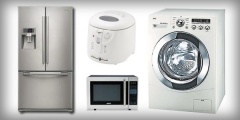Household appliances, white goods
| Infobox on Household appliances, white goods | |
|---|---|
| Example of Household appliances, white goods |  |
| Facts | |
| Origin | - |
| Stowage factor (in m3/t) | - |
| Humidity / moisture | - |
| Ventilation | - |
| Risk factors | See text |
Household appliances, white goods
Contents
Description / Application
A major appliance, or domestic appliance, is usually defined as a large machine which accomplishes some routine housekeeping task, which includes purposes such as cooking, or food preservation, whether in a household, institutional, commercial or industrial setting. An appliance is differentiated from a plumbing fixture because it uses an energy input for its operation other than water, generally using electricity or natural gas/propane. An object run by a watermill would also be considered an appliance. The term white goods or whiteware is also used for these items, primarily where British English is spoken, although definitions for the term "white goods" can differ. In the United States, the term white goods more commonly refers to linens rather than appliances.
Major appliances have become more technically complex from the control side recently with the introduction of the various Energy Labelling rules across the world. This has meant that the appliances have been forced to become more and more efficient leading to more accurate controllers in order to meet the regulations.
Major appliances are differentiated from small appliances because they are large, difficult to move, and generally fixed in place to some extent. They are often considered fixtures and part of real estate and as such they are often supplied to tenants as part of otherwise unfurnished rental properties. Another frequent characteristic of major appliances is that they may have substantial electricity requirements that necessitate special electrical wiring to supply higher current and/or voltage than standard electrical outlets can deliver. This limits where they can be placed in a home.
Refrigeration equipment
- Freezer
- Refrigerator
Stoves
- Cooker, also known as range, stove, oven, cooking plate, or cooktop
- Microwave oven
- Washing equipment
- Washing machine
- Clothes dryer
- Drying cabinet
- Dishwasher
Miscellaneous
- Air conditioner
- Water heater
- Computer
- Television
Shipment / Storage / Risk factors
Homehold appliances are sensitive to impact, vibrations and pressure as well as to climatic stresses.
As homehold appliances are usually valuable, packaging must be adequate i.e. provide protection against impact, vibratory and compressive stresses; the inner packaging consisting of plastic materials (cushioning material), e.g. moldings, loose fill particles, bubble wrap or airbags. Scratch-sensitive surfaces are to be protected by plastic films, foam sheets or tissue paper, which must be chemically neutral and soft. Corners are to be protected by edge protectors.
To avoid damage caused by damp weather (snow, rain), solar radiation, contamination (dust) and theft, homehold appliances should not be subjected to storage or intermediate storage in the open.
Where this cargo is packaged in cartons, it must be ensured that the paperboard used is of wet strength and that closures, adhesive strips, metal clips and steel and plastic strapping are attached in such a way that the packaging openings are completely closed. Cartons used for packaging large appliances (e.g. televisions) which nonetheless have to be handled manually should be provided with carrying handles/recesses, which should be placed in accordance with the center of gravity of the appliance. The water content of a paperboard carton should be at most 5 - 8%, while that of box packaging should be at most 12 - 18%.
Palletized cargo units and large appliances should be enclosed in shrink or stretch films on the one hand to protect against damage and on the other to reduce the risk of theft. Company, promotional and appliance details should be omitted.
Adequate transport markings should be applied, viz.:
- Fragile, Handle with care
- Top
- Keep dry
- Stacking limitation
- No hand truck here











